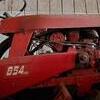
Onan P-Series Ignition Module Replacement [Photos]
By
Duramax7man7, in Engines
-
Similar Content
-
 By lsc1257
By lsc1257
I have a 1996 520H Wheel Horse for sale. The tractor has just over 800 hours on it. It comes with a 48 inch deck. The deck is a 1995 and has over 1,500 hours on it, as it came brand new with my 312-8 that I sold several years ago. This 520-H has the swept front axle so it can handle a 60 inch deck. I just replaced the battery and the deck belt this summer. The engine is a 20HP Onan and it starts right up but requires the full choke. The transmission is an Eaton 1100-062, hydrostatic. The deck is in rough shape but the spindles appear to be in good working order. The right rear tire has some cracking. The original operator's manual for the 520H is included, as is the original operating and maintenance instructions for the deck, plus the installation instructions for the deck. Also included is a new PTO belt and several miscellaneous deck wheels and rollers. Additional pictures available upon request. Asking $500.
-
 By Joe Warren
By Joe Warren
Onan model BF-MS2425A Engine for parts. This engine pulled from NOS Bolens QT16 tractor that sat for 40+ years. Engine has less than 25 hours on it. Engine currently stuck. Local pick up in Easton MA. $49 or offer.
-
 By Joe Warren
By Joe Warren
Wheel Horse
Service Tool Kit
Onan Industrial Engines
ON-420-0556
Kit is missing oil filter tool, otherwise complete. Tools in excellent condition. Small crack in plastic case, bottom, middle.
$129 plus shipping cost.
Message me if you are interested in purchasing. Thank you. Joe
-
 By Tenday
By Tenday
Experts - help please. I’m new to Wheel Horse Tractor life!
So - I’ve pulled out an inherited tractor and have decided to resurrect her. Unfortunately, no spark :/
I’m looking for help on diagnosing no spark.
model - 417-8
engine - Kohler KT17
Done thus far: (aware that some have no implication on spark.)
- new ignition switch
- new battery
- new starter
- new ignition coil and wires w/ plugs
- new condenser
- new points
- new starter solenoid
- bypassed all switches except oil and seat.
notes:
idiot lights removed.
All fuses tested with Ohms as well as visual inspection ..
coil tested w/ ohms as well
all switches bypassed except:
-oil switch ( don’t think it has any implications other than a visual indication for idiot lights. )
-seat switch
ran a pos from batt direct to pos of coil - nothing; no spark.
Electric is as follows:
- Starter switch wired to solenoid
- - solenoid to starter
- - solenoid to batt
- one wire from starter switch goes to engine ( I think this is for batt charge / flywheel)
- I have two yellow wires, which are married up, that go to engine which have constant power; They power coil. Comes from switch and seat.
Help - what the heck am I missing ?
-
 By Rollo416H
By Rollo416H
I'm new here, but I have years and miles of dealing with electrical issues with my 1997 416H, engine Onan P216G (I am the only owner) . Problem description: the start circuit turns the starter over fine, but no spark at the plugs or the coil sockets by spark tester. The ignition trigger tests good by connecting a test light to the coil positive and and the ignition trigger negative lead, plenty of light flash from the test light in unison with the engine turning over. So, I conclude the ignition trigger, replaced 3/18/2021 along with the coil is good. I have followed the "Demystification" wiring diagram in detail and there is 12V at the coil positive terminal, wiriing is solid (for now), all those damn safety switches, key switch, and relays work too. I conclude that the coil is bad since the primary side tests 3.1 OHM and the secondary tests infinite OHMS (1. displayed on multimeter). Two coils (Onan part# 166-0820) have NEW dates of 3/2021 and 8/2021, and yes both have the same test results mentioned. Infinite OHMs to me means the coil windings are broken. The most recent coil came from Onanparts.com and tested as mentioned above when it arrived. Onanparts won't take anything back! There are a lot of coils on ebay and various suppliers from China. Maybe good, maybe bad, who can tell? And most suppliers won't accept returned electrical parts. Please help: What are good test readings for a GOOD coil (primary and secondary). Who do you recommend as a reliable supplier for a new coil?
Thanks for any help!
Rollo416H
-
